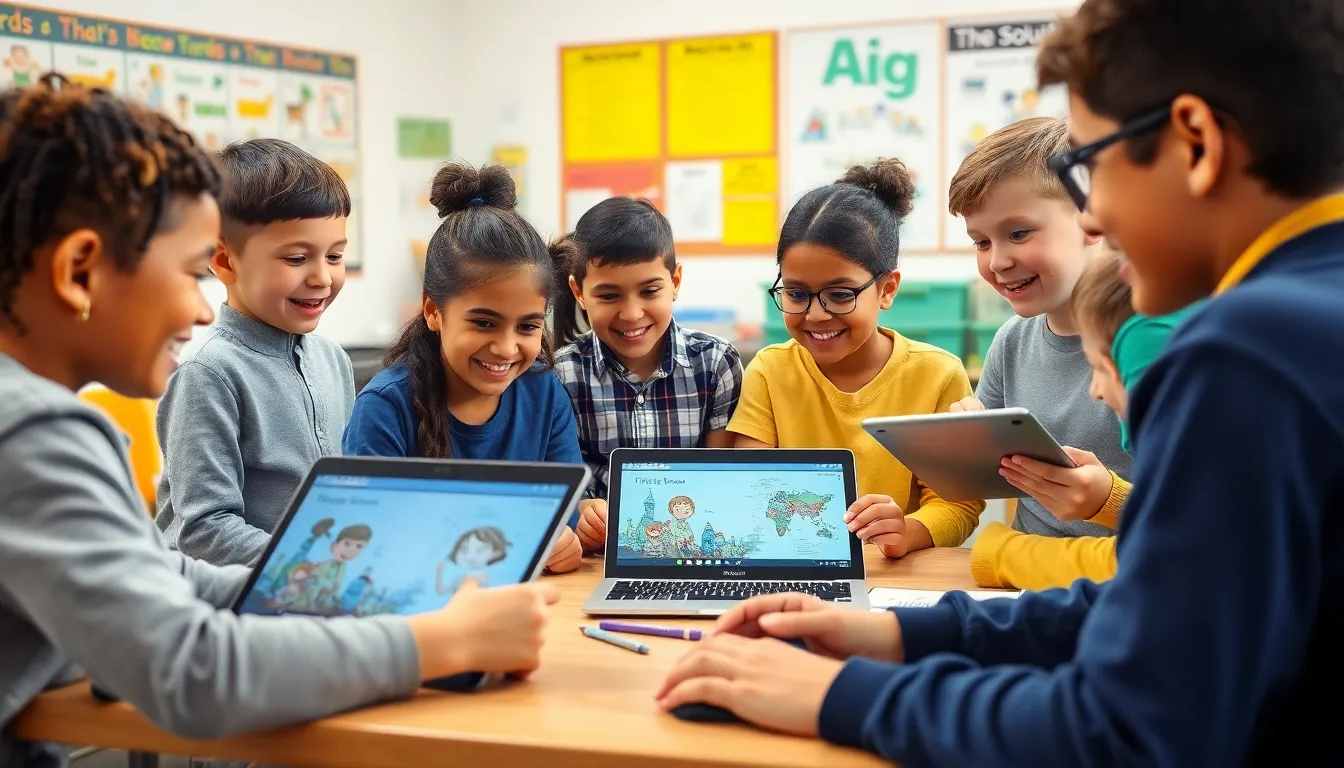Table of Contents
ToggleIn today’s tech-savvy world, digital literacy isn’t just a fancy term; it’s a survival skill for kids. Imagine a future where your child can navigate the internet like a pro, dodge online pitfalls, and even outsmart those pesky pop-up ads. Sounds like a superhero in the making, right? With the right tools and guidance, kids can transform from screen zombies into savvy digital navigators.
Understanding Digital Literacy For Kids
Digital literacy equips children with essential skills for navigating today’s digital landscape. It plays a pivotal role in fostering safe and effective technology use.
Definition and Importance
Digital literacy encompasses the ability to find, evaluate, and communicate information through digital platforms. As children interact with technology, understanding online safety becomes crucial. They must learn to critically assess sources to avoid misinformation. The importance of this skill set continues to grow, as technology becomes integral to education and daily life. Parents and educators should focus on cultivating this competence early on. Digital literacy fosters independence and promotes responsible online behavior.
Developmental Benefits
Developmentally, digital literacy enhances critical thinking and problem-solving skills. Engaging with technology allows kids to practice collaboration and creativity. They explore new ideas through research and digital projects. Moreover, these skills encourage adaptability in a rapidly changing digital world. Children gain confidence when using various tools and platforms. Studies suggest that early exposure to digital literacy correlates with better academic performance. Overall, these benefits contribute to well-rounded, informed individuals ready to navigate future challenges.
Key Components Of Digital Literacy

Digital literacy encompasses several key components essential for navigating today’s technological landscape. Understanding these components enables children to gain the skills needed for responsible online behavior.
Information Literacy
Information literacy involves the ability to locate, evaluate, and use information effectively. Children learn to distinguish between reliable and unreliable sources, fostering critical thinking skills. Mastering research techniques helps them find accurate information online and assess its relevance. By analyzing the credibility of various platforms, kids develop discerning judgment. Information literacy also encourages effective organization of findings to support academic tasks. In a world filled with misinformation, this skill becomes increasingly vital for informed decision-making.
Communication Skills
Communication skills are integral to digital literacy, enabling kids to express ideas clearly across various digital platforms. Developing strong written and verbal communication enhances their ability to engage in online discussions and collaborate with peers. Children learn to use different tools, such as emails and messaging apps, for effective communication. As they navigate social media, understanding etiquette and appropriate tone becomes critical. Moreover, sharing information responsibly fosters positive interactions and helps avoid misunderstandings. This component builds confidence in their ability to convey messages in a digital space.
Online Safety Awareness
Online safety awareness is crucial for protecting children in the digital realm. Recognizing potential online threats, such as phishing scams and cyberbullying, equips kids to navigate safely. They learn to safeguard personal information and understand the importance of privacy settings on social media. Engaging in discussions about respectful online behavior contributes to a positive digital environment. When kids are aware of potential dangers, they make informed choices while interacting with others online. Cultivating a culture of safety fosters resilience and encourages responsible digital citizenship.
Strategies To Enhance Digital Literacy
Enhancing digital literacy in children involves various strategies that engage their curiosity and foster essential skills.
Interactive Learning Tools
Interactive learning tools play a vital role in enhancing digital literacy. Platforms like coding games or educational apps boost children’s engagement with technology. Using gamified learning encourages creativity while teaching coding fundamentals. Visual simulations help kids understand complex concepts by providing hands-on experiences. Apps that promote problem-solving skills allow children to think critically as they navigate challenges. Teachers and parents can find numerous resources tailored for different age groups, making learning accessible and enjoyable.
Parental Involvement
Parental involvement significantly influences children’s digital literacy development. Active participation in online activities encourages discussions about digital experiences. When parents explore technology with their children, they model responsible online behavior. Setting boundaries on screen time helps instill balance in digital consumption. Open conversations about online safety reinforce awareness of potential dangers. Engaging children in setting personal technology goals fosters independence and accountability. Parents can also share resources that promote healthy digital habits, ensuring a consistent approach to learning.
Challenges And Barriers
Digital literacy faces several significant challenges and barriers that hinder children’s ability to thrive in a technological world. Addressing these obstacles is essential for fostering effective digital skills.
Access to Technology
Access to technology plays a pivotal role in shaping digital literacy. Many families lack reliable internet connections or devices, which limits children from engaging with digital tools. Equal access ensures that all kids can participate in online learning, but disparities exist. Urban areas often have more resources than rural locations, creating significant gaps. Schools with limited budgets may provide inadequate technology, further amplifying these disparities. Those who navigate digital platforms effectively often come from households with abundant resources. Bridging this gap requires community initiatives and investments in infrastructure to ensure every child has the tools for success.
Socioeconomic Factors
Socioeconomic factors significantly influence children’s digital literacy development. Families with lower incomes may prioritize essential needs over technology, reducing children’s exposure to digital resources. Limited financial means often correlate with lesser educational opportunities in digital skills. Those in higher-income brackets usually have access to diverse technology and educational support. Schools in affluent areas frequently offer enriched programs to bolster digital literacy. Addressing these socioeconomic barriers entails creating policies that ensure equitable access, enabling all children to gain essential digital skills regardless of their background. Initiatives that focus on providing resources in underserved communities can foster inclusion and empowerment for every child.
Digital literacy is no longer just an advantage; it’s a necessity for children in today’s world. By equipping them with the right skills and knowledge, parents and educators can empower kids to navigate the digital landscape confidently and safely. This foundation not only prepares them for academic success but also fosters essential life skills like critical thinking and creativity.
As technology continues to evolve, ongoing support and resources are crucial to ensure every child has the opportunity to thrive. Addressing barriers to access and promoting inclusive practices will create a more equitable environment where all kids can develop the digital literacy skills needed for a successful future. Prioritizing digital literacy today will pave the way for informed and responsible digital citizens tomorrow.







